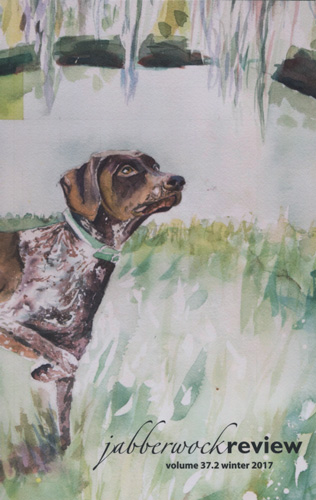Jabberwock Review – Winter 2017
Looking back through old family snapshots, a majority include a four-legged family member: Sadie our German Shorthaired Pointer. It has been almost ten years since she passed away, but every time I see the same breed of dog as Sadie, I can’t help thinking of my childhood companion. Upon seeing the German Shorthaired painting by Katie Erickson on the cover of the Winter 2017 issue of the Jabberwock Review, I was flooded with nostalgia, a bittersweetness that followed me throughout the issue.
Looking back through old family snapshots, a majority include a four-legged family member: Sadie our German Shorthaired Pointer. It has been almost ten years since she passed away, but every time I see the same breed of dog as Sadie, I can’t help thinking of my childhood companion. Upon seeing the German Shorthaired painting by Katie Erickson on the cover of the Winter 2017 issue of the Jabberwock Review, I was flooded with nostalgia, a bittersweetness that followed me throughout the issue.
In “Bagmen,” Jennifer Maritza McCauley presents sweetness by bringing family together, but at a bitter price. Kaleb, the narrator, is young, black, and struggling at school—where he is bullied, one of two black children who have transferred to a previously-segregated school—and at home where an alcoholic mother views him and his older sister as her only sources of happiness and chance at success. But there is a third sibling, a secret sibling whose arrival topples from the young narrator’s shoulders the heavy weight of race, religion, family ties, and the expectations that accompany each. Maritza McCauley arrests readers, tension building like a lump in a throat until it finally explodes.
Mary Maroste stirs up feelings of nostalgia in “Tannery Creek in October,” images of Northern Michigan reminding me of my own childhood. Maroste writes of lush nature: tadpoles, lily pads, sappy water, hostas. Death and dying and the subsequent ache of the surviving spill between these images, a swampy, murky poem that explores loss and memory.
Karen Ellmann, the narrator of James Gyure’s “First Tomatoes of the Season,” also faces loss. She copes by eating meals at her deceased husband’s grave and leaving behind items of food in lieu of plastic flags or angel statues. When complaints about her food-bearing behavior threaten to put an end to her unique grieving process, Karen struggles with letting go, not only of her husband, but also the confrontation that soon arises. Gyure’s narrator stands strong in solitude and in the face of adversity, and I appreciated her creativity as she quietly rages against the socially-approved displays of grief.
The issue closes with three poems by Nancy Reddy, “The Moon at Midcentury” and “Domestic Science” reading as a single two-part poem. Both say they require a man—one for symmetry, the other for closure—and both attracted me with sharp images of the summer season fading into fall. In “The Moon at Midcentury”: “A moth buzzes / beneath the neighbor’s porch light. Somewhere / down the street a storm door swings and claps,” and in “Domestic Science”: “[ . . . ] the crab apples turning to liquor and mush / beside the garage. A glass of iced tea sweats against your palm / and in the distance, the high school’s marching band calls down the dusk,” bringing the season’s evenings to life. Together, Reddy’s poems create closure, both in regard to feelings of summer, and this issue of Jabberwock Review itself.
I’m aware not all readers will have the same bittersweet pull of nostalgia that brought me to this issue, but they will be just as impressed by the writing found inside. Published by students and faculty of Mississippi State University, the editors insure each issue of Jabberwock Review is a showcase of strongly written poetry and prose, the Winter 2017 issue hitting its mark.
[www.jabberwock.org.msstate.edu]





